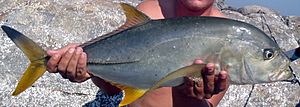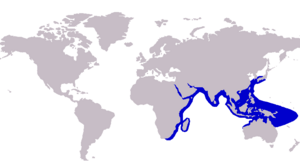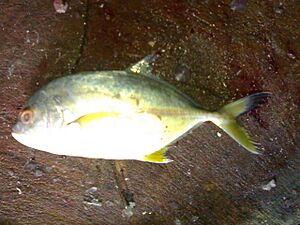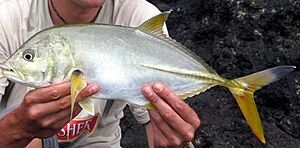Blacktip trevally facts for kids
Quick facts for kids Blacktip trevally |
|
|---|---|
 |
|
| Conservation status | |
| Scientific classification | |
 |
|
| Approximate range of the blacktip trevally | |
| Synonyms | |
|
The blacktip trevally (Caranx heberi) is a large ocean fish. It is also known as the blacktip kingfish or yellowtail kingfish. This fish belongs to the jack family, called Carangidae. You can find the blacktip trevally in warm, tropical parts of the Indian Ocean and Pacific Ocean. Its home stretches from South Africa all the way to Fiji, Japan, and northern Australia.
This fish lives in coastal waters, especially in clear, deep areas. It likes rocky places and coral reefs. The blacktip trevally is easy to spot because of its bright yellow fins. It also has a dark upper tail fin, which gives it its name. This fish can grow up to 1 meter (about 3 feet) long. It is a hunter that eats other fish, squid, and crabs. Blacktip trevally often swim in small groups called shoals. People catch them for food and for sport fishing.
Contents
What is a Blacktip Trevally?
The blacktip trevally is a type of fish in the Caranx group. This group includes many kinds of jacks or trevallies. The Caranx group is part of a bigger fish family called Carangidae. This family also includes horse mackerels.
Scientists first described this fish in 1830. A scientist named John Whitchurch Bennett gave it the name Scomber heberi. He found the first example of the fish in Sri Lanka. Later, it was moved to the Caranx group, where it still belongs today.
Where Do Blacktip Trevally Live?
Blacktip trevally live in warm, tropical, and subtropical waters. You can find them across the Indian Ocean and the western Pacific Ocean.
In the west, they live from South Africa and Madagascar. Their range goes north along the east African coast. It reaches up to the Persian Gulf and the Red Sea. They also live eastward through India, Southeast Asia, and the Malay Archipelago. Their home extends south to northern Australia. It goes north to Japan and east to Fiji.
These fish mostly stay close to shore. Adult blacktip trevally prefer clear, open coastal waters. Young fish are often found in large bays and estuaries (where rivers meet the sea). Adults often live over rocky reefs and tall underwater rocks. They also like open sandy areas.
How to Identify a Blacktip Trevally
The blacktip trevally is a big fish. It can grow up to 1 meter (3 feet) long. It can weigh up to 12.5 kilograms (about 27.5 pounds). Like most jacks, it has a flat, oval-shaped body. Its back is more rounded than its belly.
Its top fin (dorsal fin) has two parts. The first part has 8 stiff spines. The second part has 1 spine and 19 to 21 soft rays. Its bottom fin (anal fin) has 2 separate spines at the front. Then it has 1 spine and 15 to 17 soft rays. The fins on its belly (ventral fins) have 1 spine and 5 soft rays. Its tail fin is deeply forked, like a "V".
The blacktip trevally has a special line along its side called a lateral line. This line helps it feel vibrations in the water. It has scales on its body. Some fish have scales all over their chest, while others have a bare spot.
The color of the blacktip trevally is very special. Its upper body is dark bronze to yellow-green. Its lower body is silvery-white. Its tail fin is bright yellow or olive yellow. The top part of the tail fin is usually black or very dark. This black tip is how the fish got its common name. Other fins can be bright yellow or a bit dark. Unlike some other fish in its family, it does not have a dark spot on its gill cover.
Behavior and Lifestyle

Blacktip trevally can swim alone or in small groups called shoals. Young fish are more likely to be in shoals. These fish seem to travel from place to place. For example, in South Africa, many arrive in the summer. In India, they show up after the monsoon rains.
This fish is a hunter. It finds its food both on the seafloor and higher up in the water. They eat many different things. Their diet includes other fish, squid, and crustaceans. Crustaceans are like shrimp, mantis shrimp, crabs, and crayfish.
Scientists don't know much about how blacktip trevally reproduce. But they think these fish lay their eggs in the warmer, tropical parts of their range. They become ready to reproduce when they are about 50 cm (20 inches) long.
Blacktip Trevally and People
Blacktip trevally are not a huge part of commercial fishing. But people do catch them using hooks and lines or different types of nets. They are sold fresh, salted, or dried in markets.
These fish are popular with people who like to fish for sport. They are known for being strong fighters when caught on a line. When you pull them out of the water, they sometimes make a grunting sound, like a young pig. Many people think they are very tasty to eat.
The biggest blacktip trevally ever caught with a fishing rod weighed 8.20 kg (18 pounds, 1 ounce). This record fish was caught in Mozambique in 2008.
Images for kids
See also
 In Spanish: Caranx heberi para niños
In Spanish: Caranx heberi para niños




